Ouranion Mimèma, The Kugel Globe, c 300 - 100 BC
|
Definition: [Source Texts of Astrology] One of only three surviving celestial globes dating from the Classical period. This one is with the Gallery J. Kugel Antiquaries in Paris. It is difficult to date, but may be from the second or third century BC. If so, it is the oldest celestial globe still in existence, and not much younger than the seminal celestial globe of antiquity, said to have been fashioned by Eudoxus of Knidos [c 360 BC.]. Libra Not Yet a Zodiac Sign: As with the several centuries younger Mainz Globe, Libra isn't shown on the Kugel Globe, rather the claws of Scorpius occupy where we now consider the stars of Libra to be present. [On the Kugel Globe, no attempt has been made to show equal areas for the Zodiac Signs. unlike the later Mainz Globe.] The Vernal Equinox in Aries: The most important insight for astrology of the Kugel Globe is the positioning of the Vernal Equinox Point. This lies between the front legs of Aries [whereas on the Mainz Globe it is depicted as lying between Aries and Pisces]. This is pictorial confirmation of the information given by Manilius in Astronomica and by many of the surviving Classical horoscopes, that the Vernal Equinox Point was considered to lie at 10° or 8° Aries in the early Classical period. This is consistent with the actual Position of the Vernal Equinox Point perhaps a century earlier than when the Kugel Globe is likely to have been made. |
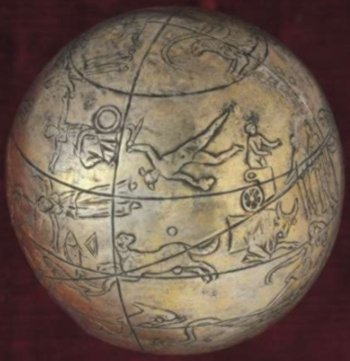
The Kugel Globe, c 300 - 100 BC. Shown from the top and left to right are Cassiopeia, the Queen, then Andromeda, the Princess, Perseus, the Hero, Auriga, the Charioteer. On the Ecliptic , Pisces, the Fishes, Aries, the Ram, Taurus, the Bull, Gemini, the Twins, with Cetus, the Whale below [in the form of a dolphin]. [Click on the above for a higher resolution version, 89 kB.] The Ecliptic is the line going from bottom left to top right. The Great Circle of the Vernal Equinox is going from the top to the bottom of the globe. Where they meet is the Vernal Equinox Point. This is firmly within Aries, reflecting the Position of the Vernal Equinox Point at that time.
|
|
'Silver Celestial Globe from Antiquity': Hélène Cuvigny [Copyright of this text resides with the author.] Although numerous representations of the twelve signs of the zodiac survive in the art of Antiquity, this silver celestial globe is one of only three surviving globes which reproduce all the constellations known to the ancient world. The remaining two are the marble globe of the Farnese Atlas, in the National Museum of Naples [1st or 2nd century AD], and a Small Brass Globe recently acquired by the Roman-Germanic Museum in Mainz [c 150 - 220 AD]. Made of precious metal, the present sphere is the work of a goldsmith who was not knowledgeable in astronomy and was probably simply copying from an existing sphere, likely to have been a repaired celestial globe, since he appears to have reproduced its rivets faithfully, taking them for celestial symbols: these are the small circles beneath Ursa Major and a square above Leo. The globe is far from respecting the astronomical norms of the period as defined by Hipparcus, although the position of the constellations in relation to the main astronomical circles is not arbitrary. Notable mistakes include: the huge size and orientation of Gemini (who should lie in the ecliptic, but are instead perfectly perpendicular to the parallel circles so that their legs occupy the space which should contain Orion’s torso); the pincers of Cancer failing to turn toward Leo; the head of Draco passing south of the Arctic circle (it should be under the foot of the Hercules who is supposed to be crushing it); Boötes floating parallel to the tropic, cut off at the hips by the equinoctial colure (he ought to be standing on the tropic); and Cassiopea seated, parallel to the tropics, on the equinoctial colure (she should be resting on the Arctic circle since she was suspended in the sky upside-down as a punishment for her pride). Certain other iconographic peculiarities are also worth mentioning. The most interesting concerns the ties linking the two fish of Pisces: instead of joining each other behind Cetus they descend from one of the front hooves of Aries. This goes back to an early iconographical tradition deriving from the Catastérismes of Eratosthenes (and the De Astronomia of Hygin, which derives from it). Sagitta, the Arrow, absent from the Farnesi globe and of undefined form in the Mainz sphere, is easily identifiable here. Its middle portion is crossed by the solstitial colure (it should be to the east of this circle), which may reflect, again, a tradition echoed in the Catastérismes and in Hygin. Triangulum, the Triangle, which is not represented in the other two globes, is also present. The constellation of the Horse has no wings (and therefore could not strictly-speaking be called Pegasus), which is unique in the iconography of this constellation, though it reflects astronomical doctrine until Ptolemy (circa 150 A.D.), who was the first astronomer to annex stars in Pegasus unambiguously as wings. However, before Ptolemy, the Horse had sometimes been identified with Pegasus, as suggested by a passage from the Catastérismes, which shows that during the 3rd century B.C. the two traditions of the iconography of this constellation were in conflict: “One only sees the fore-body of the Horse, up to his navel. According to Aratos, this is the horse Helicon, who, with one stroke of his hoof, caused to spring forth the fountain which for this reason is called Hippocrene (Fountain of the Horse). Others say it is Pegasus, the horse who flew to the stars after the fall of Bellerophon. However certain people find this interpretation unlikely, since the figure has no wings.” Another notable feature is that the head of Andromeda touches the belly of the Horse, alpha-Andromedae being the same star as delta-Pegasi, a characteristic also commented upon by Aratos. In the case of Cetus, the whale pursuing Andromeda, the engraver has invested little imaginative effort, merely representing it as a dolphin only a little more menacing than the constellation of the same name, instead of as a sea dragon. This naturalistic bias can perhaps be explained by the semantic ambivalence of the word kètos, which in Greek signifies not only fabulous sea monsters, but also normal cetaceans (as in Aristotle) and all fish of large size. The constellations representing people and animals are not interpreted as mythological characters but as naked figures without attributes: the twins of Gemini are not identified with Castor and Pollux (or with any other notable twins); the Kneeling Man is not identified with Hercules, nor the Water Bearer with Ganymede. The various constellations might have been copied from different sources because of their stylistic discrepancies: Aries, Cygnus, and Lyra are all finely executed, whereas the two dogs of Boötes are only roughly depicted. Except for Aries and Leo, the quadrupeds are hardly individualised: Ursa Major and Minor (the two bears) and Lepus (the hare) all resemble canines. The male figures also have rather youthful anatomy. An important characteristic of the globe further demonstrates that the engraver ignored, or was unaware of, the norms of representation of the constellations: he has not depicted the constellations from the point of view of an observer outside the celestial sphere looking in (with the backs of the constellations turned towards the viewer), but quite the opposite. All the figures which should be seen from the back are shown from the front, with the exception of Sagittarius. As a consequence, he has depicted several figures left-handed: Aquarius, Perseus (holding his harp with his left hand), and Orion (whose tunic reveals his left shoulder). Only one error of this type was made by the creator of the Farnese globe, which shows Andromeda from the front, but with her foot turned so that the sole can be seen. The errors are more frequent on the Mainz sphere, but not as consistent as here. Unfortunately, the iconographic details of the globe do not help to date it with any great precision. Certain details suggest the end of the Hellenistic period (the 2nd and 3rd centuries B.C.), since they are related to the texts of Aratos: the absence of wings on the Horse and Virgo; the shape of Libra (here treated in the antique manner, that is, like the pincers of Scorpio, although this iconography survives until the 3rd century A.D.); and the form of the Charioteer’s chariot, which is more akin to ancient Greek and Hellenistic chariots than it is to the familiar Roman examples. Conversely, the figure of Cassiopeia is suggestive of the Roman Imperial period. Curiously, her throne takes the shape of a ring, evoking representations found on coins of the goddess Rome, sitting with a round shield beside her (such coins are mentioned from the end of the 2nd century until the Tetrarchy of the 3rd century A.D.). Perhaps rather than indicating a later date this is simply symptomatic of the artist making the mistake of engraving Corona Borealis in the wrong place, and to disguise his error transforming it into Cassiopeia’s throne. We have found on several places the influence of a tradition close to the Catastérismes and to Hygin, however this globe does not follow a pure literary tradition. There is clearly no influence of Ptolemy: the three constellations that the latter has described as inverted, the Eagle, the Altar and the fish are here turned towards the north. It is unlikely that the sphere ever rested on the shoulders of a statue of Atlas: such statues are rare and the opening at the south pole suggests a single point of attachment. Antiquity has left many representations of spheres placed on columns. This was no doubt the case with this sphere, which in many ways is reminiscent of the gift of the poet Leonidas of Alexandria to Poppea on her birthday, which he called an ouranion mimèma, or ‘imitation of the heavens’. |
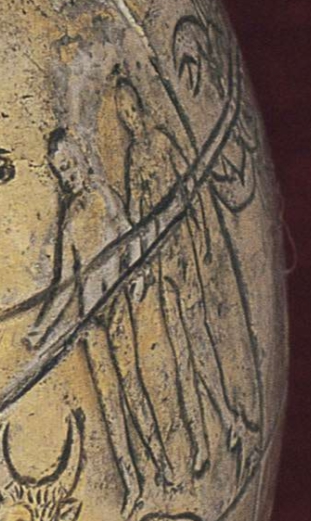
The Kugel Globe. Gemini, the Twins, and the claws of Cancer, the Crab.
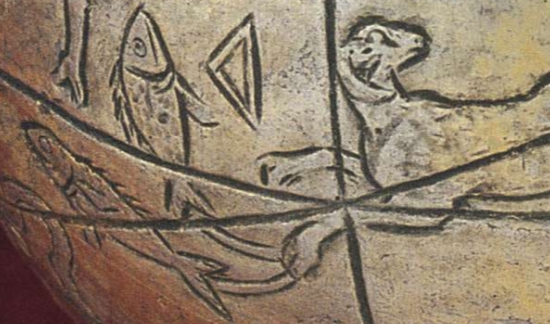
The Kugel Globe. Pisces, the Fishes, Triangulum, the Triangle and Aries, the Ram. The Vernal Equinox Point in Aries.
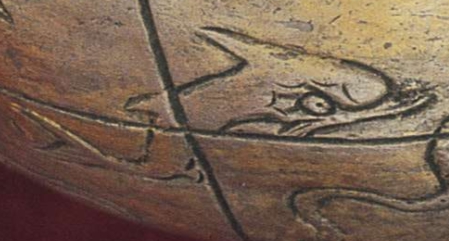
The Kugel Globe. Cetus, the Whale, in the form of a dolphin.
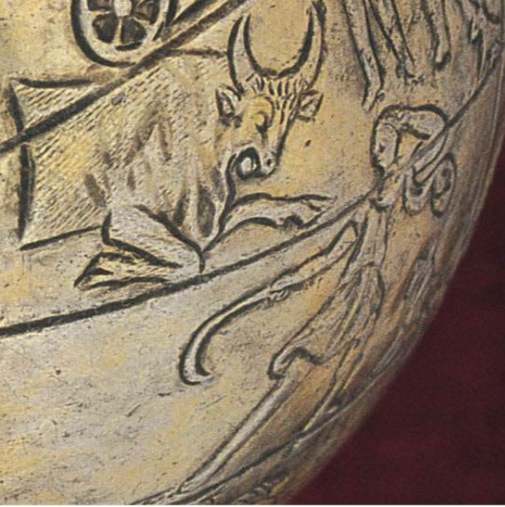
The Kugel Globe. Taurus, the Bull, with Orion, the Hunter.

The Kugel Globe. Cassiopeia, the Queen, and Andromeda, the Princess.

The Kugel Globe. Auriga, the Charioteer

The Kugel Globe. Perseus, the Hero.
|
© Dr Shepherd Simpson, Galactic Astrologer [except where the work of others has been quoted]
The Galactic Astrologer
Do you want to know more about Galactic Astrology ?
Then enter the Galactic Zodiac
See the new Astrological Index for the meaning of other astrological words and phrases